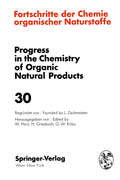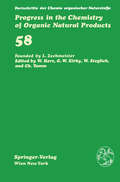- Table View
- List View
Fortschritte der Chemie organischer Naturstoffe / Progress in the Chemistry of Organic Natural Products (Fortschritte der Chemie organischer Naturstoffe Progress in the Chemistry of Organic Natural Products #75)
by M. T. Collett M.T. Davies-Coleman D. C. Gournelis G. G. Laskaris D.E.A. Rivett R. VerpoorteThe volumes of this classic series, now referred to simply as "Zechmeister” after its founder, L. Zechmeister, have appeared under the Springer Imprint ever since the series’ inauguration in 1938. The volumes contain contributions on various topics related to the origin, distribution, chemistry, synthesis, biochemistry, function or use of various classes of naturally occurring substances ranging from small molecules to biopolymers. Each contribution is written by a recognized authority in his field and provides a comprehensive and up-to-date review of the topic in question. Addressed to biologists, technologists, and chemists alike, the series can be used by the expert as a source of information and literature citations and by the non-expert as a means of orientation in a rapidly developing discipline.
Fortschritte der Chemie Organischer Naturstoffe / Progress in the Chemistry of Organic Natural Products (Fortschritte der Chemie organischer Naturstoffe Progress in the Chemistry of Organic Natural Products #30)
by M. J. Cormier H. Flasch B. Franck K. Hori L. Jaenicke W. Keller-Schierlein H. D. Locksley D. G. Müller J. Polonsky R. Tschesche J. E. Wampler G. WulffFortschritte der Chemie organischer Naturstoffe / Progress in the Chemistry of Organic Natural Products (Fortschritte der Chemie organischer Naturstoffe Progress in the Chemistry of Organic Natural Products #48)
by P. Crews R. E. Moore S. Naylor P. S. Steyn R. VleggaarFortschritte der Chemie Organischer Naturstoffe / Progress in the Chemistry of Organic Natural Products (Fortschritte der Chemie organischer Naturstoffe Progress in the Chemistry of Organic Natural Products #36)
by C.W.J. Chang I. Flament J. A. Matson T. Nishida G. Ohloff F. W. Wehrli A. J. WeinheimerSince the late 1950's when proton n. m. r. spectroscopy was first used in organic natural products studies the technique has increasingly con of this important area of chemistry. tributed to the rapid advancement Although the potential utility of 13C n. m. r. was recognized very early, essentially no application of 13C n. m. r. appeared in the literature prior to 1966 and 95% of the existing data are less than five years old. The initially slow growth had its cause in inadequate instrumentation, insufficient sensitivity being the main obstacle. This situation drastically changed with the advent and commercial availability of broadband ex citation and Fourier transform methods, giving natural-abundance 13C n. m. r. and its numerous chemical applications a tremendous impetus. Today BC spectra can be recorded on sample quantities down to the submilligram level, which until recently even withstood proton n. m. r. Paralleling the development of experimental techniques considerable progress has also been made on an understanding of spectral parameters, in particular their stereochemical implications on natural products. Although the large majority of data present up to now deals with known structures, an adequate basis now exists which allows the chemist to use the technique for tackling real problems on unknown molecules.
Fortschritte der Chemie organischer Naturstoffe / Progress in the Chemistry of Organic Natural Products (Fortschritte der Chemie organischer Naturstoffe Progress in the Chemistry of Organic Natural Products #80)
by C.W.J. Chang H. Greger O. HoferFortschritte der Chemie organischer Naturstoffe / Progress in the Chemistry of Organic Natural Products (Fortschritte der Chemie organischer Naturstoffe Progress in the Chemistry of Organic Natural Products #41)
by J. W. Daly D. Ferreira S. J. Gould E. Haslam D. J. Robins D. G. Roux S. M. WeinrebThe chemistry of condensed tannins has hitherto represented a relatively unattractive and therefore neglected area of study; one in which the weight of research effort involved is invariably disproportionate to the results achieved, in which the participating schools generally confine their approach to specific molecular species, and in which as yet no consensus has been reached regarding likely precursors. The problems which beset those engaged in this field represent a combined function of the abnormal complexity of the gradational range of oligomers of increasing mass and affinity for substrates which typify most extracts rich in tannins, and the consequent problem of their isolation and purification, the high chirality of tannin oligomers, the need to contend with the phenomenon of dynamic 'rotational isomerism about interflavanoid bonds in the IH n.m.r. spectral interpretation of their derivatives, the lack of precise knowledge regarding the points of bonding at nucleophilic centres, and the obvious limitations of a hitherto predominantly analytical approach. The last of these reflects the need for a general method of synthesis which permits unambiguous proof of both structure and absolute configuration also at higher oligomeric levels. With these objectives in mind we initiated a purely synthetic approach based on the premise that flavan-3,4-diols as source of electrophilic flavanyl-4-carbocations, and flavan-3-0Is as nucleophiles (cf 1,2) represent the prime initiators of a process of repetitive condensation in which the immediate products also represent the sequent nucleophilic substrates.
Fortschritte der Chemie organischer Naturstoffe / Progress in the Chemistry of Organic Natural Products (Fortschritte der Chemie organischer Naturstoffe Progress in the Chemistry of Organic Natural Products #61)
by D.G.I. Kingston A. A. Molinero J. M. RimoldiContents: D. G. I. Kingston, A. A. Molinero, and J. M. Rimoldi: The Taxane Diterpenoids. - Author Index. - Subject Index. The volumes of this classic series, now referred to simply as "Zechmeister" after its founder, L. Zechmeister, have appeared under the Springer Imprint ever since the series' inauguration in 1938. The volumes contain contributions on various topics related to the origin, distribution, chemistry, synthesis, biochemistry, function or use of various classes of naturally occurring substances ranging from small molecules to biopolymers. Each contribution is written by a recognized authority in his field and provides a comprehensive and up-to-date review of the topic in question. Addressed to biologists, technologists, and chemists alike, the series can be used by the expert as a source of information and literature citations and by the non-expert as a means of orientation in a rapidly developing discipline.
Fortschritte der Chemie organischer Naturstoffe / Progress in the Chemistry of Organic Natural Products (Fortschritte der Chemie organischer Naturstoffe Progress in the Chemistry of Organic Natural Products #59)
by A. M. Eklund S. I. Hatanaka I. WahlbergThe volumes of this classic series, now referred to simply as Zechmeister after its founder, L. Zechmeister, have appeared under the Springer Imprint ever since the series' inauguration in 1938. The volumes contain contributions in various topics related to the origin, distribution, chemistry, synthesis, biochemistry, function or use of various classes of naturally occurring substances ranging from small molecules to biopolymers. Each contribution is written by a recognized authority in his field and provides a comprehensive and up-to-date review of the topic in question. Addressed to biologists, technologists, and chemists alike, the series can be used by the expert as a source of information and literature citations and by the non-expert as a means of orientation in a rapidly developing discipline.
Fortschritte der Chemie organischer Naturstoffe / Progress in the Chemistry of Organic Natural Products (Fortschritte der Chemie organischer Naturstoffe Progress in the Chemistry of Organic Natural Products #45)
by J. A. Elix M. V. Sargent Y. Shimizu D.A.H. Taylor A. A. WhittonFortschritte der Chemie organischer Naturstoffe / Progress in the Chemistry of Organic Natural Products (Fortschritte der Chemie organischer Naturstoffe Progress in the Chemistry of Organic Natural Products #47)
by S. Elson I. Howe M. Jarman P. G. McDougal J. Polonsky N. R. Schmuff R. SouthgateMore than ten years have elapsed since the publication of a compre hensive review on the quassinoids, the bitter principles of the Simaroubaceae family (80). Interest in these terpenoids has increased enormously in recent years due in part to the finding of the American National Cancer Institute in the early 1970s that these compounds display marked antileukemic activity. Furthermore, a wide spectrum of other biological properties for the quassinoids has been discovered and studies on chemical modifications of inactive members to yield biologically active ones were undertaken. New structures have been established also and numerous synthetic approaches have been developed which include the total synthesis of the parent compound, quassin (p. 250) and also that of castelanolide (p. 253). It is intended that this present chapter will be an extension of my first review in this series and will contain references up to September 1984. A short article on some aspects of this subject was published recently (81). II. Quassinoid General Features In reviewing the essential features of the quassinoids, the new structural types discovered during the last decade will be emphasised. The quassinoids can be divided into distinct groups according to their basic skeletons. The five skeletons observed are presented on Chart 1.
Fortschritte der Chemie organischer Naturstoffe / Progress in the Chemistry of Organic Natural Products (Fortschritte der Chemie organischer Naturstoffe Progress in the Chemistry of Organic Natural Products #72)
by E. Fattorusso R. J. Highet D. L. Klayman A. Mangoni R.D.H. Murray H. ZifferThe volumes of this classic series, now referred to simply as "Zechmeister” after its founder, L. Zechmeister, have appeared under the Springer Imprint ever since the series’ inauguration in 1938. The volumes contain contributions on various topics related to the origin, distribution, chemistry, synthesis, biochemistry, function or use of various classes of naturally occurring substances ranging from small molecules to biopolymers. Each contribution is written by a recognized authority in his field and provides a comprehensive and up-to-date review of the topic in question. Addressed to biologists, technologists, and chemists alike, the series can be used by the expert as a source of information and literature citations and by the non-expert as a means of orientation in a rapidly developing discipline.
Fortschritte der Chemie organischer Naturstoffe / Progress in the Chemistry of Organic Natural Products (Fortschritte der Chemie organischer Naturstoffe Progress in the Chemistry of Organic Natural Products #38)
by H. D. Fischer N. H. Fischer R. W. Franck E. J. OlivierFortschritte der Chemie organischer Naturstoffe / Progress in the Chemistry of Organic Natural Products (Fortschritte der Chemie organischer Naturstoffe Progress in the Chemistry of Organic Natural Products #46)
by E. Fujita S. Johne R. Kasai M. Node O. TanakaFortschritte der Chemie organischer Naturstoffe / Progress in the Chemistry of Organic Natural Products (Fortschritte der Chemie organischer Naturstoffe Progress in the Chemistry of Organic Natural Products #73)
by T. Fukai T. NomuraFortschritte der Chemie organischer Naturstoffe / Progress in the Chemistry of Organic Natural Products (Fortschritte der Chemie organischer Naturstoffe Progress in the Chemistry of Organic Natural Products #74)
by S. Garai A.M.P. Koskinen S. B. Mahato L. A. OtsomaaSaponins are complex molecules made up of sugars linked to a triterpenoid or a steroid or a steroidal alkaloid. These natural products are attracting much attention in recent years because of the host of biological activities they exhibit. The diversity of structural features, the challenges of isolation because of their occurrence as complex mixtures, the pharmacological and biological activities still to be discovered, and the prospect of commercialization - these all are driving the study of saponins. Triterpenoid saponins are dominating constituents of this class and occur widely throughout the plant kingdom including some human foods e. g. beans, spinach, tomatoes, and potatoes, and animal feed e. g. alfalfa and clover. Saponins were initially a rather neglected· area of research primarily because of great difficulties in their isolation and characterization. With the advent of more sophisticated methods of isolation and structure elucidation through the last two decades, there has been increased interest in these natural products. Besides structure determination, research activities are now moving forward to clarify structure-activity relationships. Our previous reviews on triterpenoid saponins (l, 2) covered literature from 1979 to mid-1989. The literature on triterpenoid saponins up to 1988 has also been covered by two reviews by HILLER et at. (3, 4). This review incorporates newer trends in isolation and structure determination of triterpenoid saponins, new triterpenoid saponins isolated and biological properties of these products reported during the period late 1989-mid 1996. 2.
Fortschritte der Chemie Organischer Naturstoffe / Progress in the Chemistry of Organic Natural Products (Fortschritte der Chemie organischer Naturstoffe Progress in the Chemistry of Organic Natural Products #32)
by R. J. Highet H. Kössel P. G. Sammes P. M. Scopes W. K. Seifert H. Seliger E. A. Sokoloski H.C. Van HummelFortschritte der Chemie organischer Naturstoffe / Progress in the Chemistry of Organic Natural Products (Fortschritte der Chemie organischer Naturstoffe Progress in the Chemistry of Organic Natural Products #49)
by R. A. Hill H. C. Krebs R. Verpoorte R. WijnsmaIsocoumarins have been isolated from a wide variety of microbial, plant and insect sources and have been shown to possess an impressive array of biological activities. Since the review by BARRY in 1963 (24), the number of known naturally occurring isocoumarins has increased dramatically. This increase is largely due to improvements in isolation procedures and structural analysis. Previous reviews have concentrated on fungal isocoumarins (293,294) and mycotoxic isocoumarins (301). This review lists over 160 naturally occurring isocoumarins. Leading references on isolation, structure elucidation, biosynthesis and synthesis are given in the accompanying Tables. The known natural isocoumarins are listed in the Tables according to the number and orientation of oxygen atoms on the benzenoid ring and by carbon substituents. For completeness, those isocoumarins bearing additional fused carbocyclic rings and those containing nitro gen substituents are included in separate Tables. It is hoped that by using these Tables in conjunction with the Formula Index, the Trivial Name Index and the Source Index the reader will be able to locate key references in the literature and gain an understanding of the fascin ating chemistry and action of naturally occurring isocoumarins.
Fortschritte der Chemie organischer Naturstoffe / Progress in the Chemistry of Organic Natural Products (Fortschritte der Chemie organischer Naturstoffe Progress in the Chemistry of Organic Natural Products #81)
by S. HunekThe volumes of this classic series, now referred to simply as "Zechmeister” after its founder, L. Zechmeister, have appeared under the Springer Imprint ever since the series’ inauguration in 1938. The volumes contain contributions on various topics related to the origin, distribution, chemistry, synthesis, biochemistry, function or use of various classes of naturally occurring substances ranging from small molecules to biopolymers. Each contribution is written by a recognized authority in his field and provides a comprehensive and up-to-date review of the topic in question. Addressed to biologists, technologists, and chemists alike, the series can be used by the expert as a source of information and literature citations and by the non-expert as a means of orientation in a rapidly developing discipline.
Fortschritte der Chemie organischer Naturstoffe / Progress in the Chemistry of Organic Natural Products (Fortschritte der Chemie organischer Naturstoffe Progress in the Chemistry of Organic Natural Products #43)
by J. L. Ingham A. Koskinen M. LounasmaaFortschritte der Chemie organischer Naturstoffe / Progress in the Chemistry of Organic Natural Products (Fortschritte der Chemie organischer Naturstoffe Progress in the Chemistry of Organic Natural Products #50)
by H. Inouye L. Jaenicke M. Lounasmaa F. J. Marner U. Sequin P. Somersalo S. Uesato R. M. WengerFortschritte der Chemie organischer Naturstoffe / Progress in the Chemistry of Organic Natural Products (Fortschritte der Chemie organischer Naturstoffe Progress in the Chemistry of Organic Natural Products #89)
by Bernhard Kräutler N. P. SahuThe volumes of this classic series have appeared under the Springer Imprint ever since the series' inauguration in 1938. The volumes contain contributions on various topics related to the origin, distribution, chemistry, synthesis, biochemistry, function or use of various classes of naturally occurring substances ranging from small molecules to biopolymers. Each contribution is written by a recognized authority to provide an up-to-date review of the topic in question.
Fortschritte der Chemie organischer Naturstoffe / Progress in the Chemistry of Organic Natural Products (Fortschritte der Chemie organischer Naturstoffe Progress in the Chemistry of Organic Natural Products #55)
by M.T. Davies-Coleman J. Galambos L. Hough C. E. James R. Khan K. Krohn M. Lounasmaa D.E.A. RivettFortschritte der Chemie organischer Naturstoffe / Progress in the Chemistry of Organic Natural Products (Fortschritte der Chemie organischer Naturstoffe Progress in the Chemistry of Organic Natural Products #54)
by T. Murakami N. TanakaThe volumes of this classic series have appeared under the Springer imprint ever since L. Zechmeister founded the series in 1938. The volumes contain contributions on various topics related to the origin, distribution, chemistry, synthesis, biochemistry, function or use of various classes of naturally occurring substances ranging from small molecules to biopolymers. Each contribution is written by a recognized authority in his field and provides a comprehensive and up-to-date review of the topic in question. Addressed to biologists, technologists and chemists alike, the series can be used by the expert as a source of information and literature citations and by the non-expert as a means of orientation in a rapidly developing discipline.
Fortschritte der Chemie organischer Naturstoffe / Progress in the Chemistry of Organic Natural Products (Fortschritte der Chemie organischer Naturstoffe Progress in the Chemistry of Organic Natural Products #58)
by R.D.H. Murray J. A. Robinson0 e The volumes of this classic series, now referred to simply as "Zechmeister" after its founder, L. Zechmeister, have appeared under the Springer Imprint ever since the series' inauguration in 1938. The volumes contain contributions related to the origin, distribution, chemistry, synthesis, biochemistry, function or use of various classes of naturally occurring substances ranging from small molecules to biopolymers. Each contribution is written by a recognized authority in his field and provides a comprehensive and up-to-date review of the topic in question. Addressed to biologists, technologists, and chemists alike, the series can be used by the expert as a source of information and literature citations and by the non-expert as a means of orientation in a rapidly developing discipline.
























